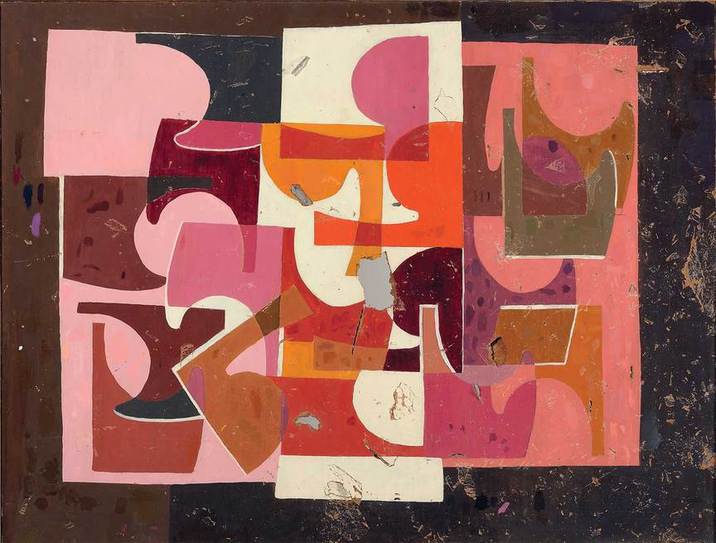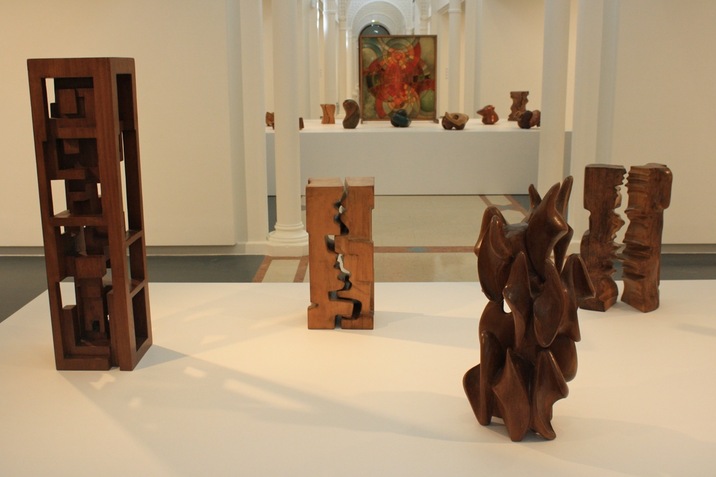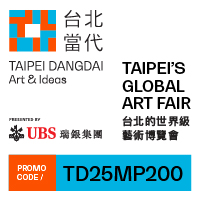Obituary: Saloua Raouda Choucair (1916–2017)
By HG Masters

Saloua Raouda Choucair in her Beirut studio in 1974. Copyright Saloua Raouda Choucair Foundation, Beirut. Courtesy Agial Art Gallery, Beirut.
One of Lebanon’s leading abstract painters and sculptors, whose work received international acclaim only later in her life, Saloua Raouda Choucair died at the age of 100 on January 27 in Beirut. Her death was announced by CRG Gallery, in New York. Choucair was the subject of major retrospectives at the Beirut Exhibition Center in 2011, and London’s Tate Modern in 2013, and was featured in important exhibitions at Mathaf: Arab Museum Modern Art, in Doha, in 2010 and 2015. In a belated recognition of her importance in the history of modernism in Lebanon and in Europe, her work is now in the collection of many prominent museums, including Mathaf, Tate Modern, the Art Institute of Chicago, Centre Pompidou in Paris, Sharjah Art Foundation and the Guggenheim Abu Dhabi.
Born in 1916 in Beirut, Choucair began her artistic training an apprentice in the studios of two important painters in Lebanon: first with Moustafa Farroukh, beginning in 1935, and then Omar Onsi in the early 1940s. A year spent in Cairo in 1943 proved to be seminal in cultivating her lifelong interest in and study of Islamic art. Returning to Lebanon, Choucair then studied philosophy at the American University of Beirut from 1945–47. Her exhibition in 1947 at the Arabic Cultural Centre has been cited by art historian Salwa Mikdadi as one of first instances of abstract art in the region.
Choucair’s second period of artistic education were the three years she spent in Paris, from 1948 to 1951, where she first enrolled at L’École des Beaux Arts. She found the school to be conservative, and so began taking classes at Académie de la Grande Chaumière, and went on to apprentice in the studio of Fernand Léger after the latter’s return from exile in the United States. In 1950, Choucair joined the newly opened Atelier d’Art Abstrait, down the street from the Grand Chaumière in Paris’s 6th arrondissement. She returned to Beirut in 1951 where she lived and worked for the rest of her life, except for periodic returns to France including in 1969.

TWO=ONE, 1947
Saloua Raouda Choucair’s work Two=One (1947–51), with its interlocking and overlapping forms, is representative of her midcentury modernist style and her interest in modular forms and can also be seen to echo Arabic calligraphy—a salient reference that would run through her abstractions on canvas and in sculpture over the next half century. The iconic painting has a hole in the center, its own scar from Lebanese history. It was damaged during the civil wars (1975–90) when a bomb blast shattered Choucair’s window and sent glass shards through the canvas.
Though Choucair trained primarily as a painter, she began experimenting with sculpture in the 1950s with her “Trajectory of a Line” series (1957–59) that featured many of the same organic forms as in her two-dimensional works to that point, with holes and carved indentations running right through the forms. Choucair was equally inspired by mathematics and science, the concepts of infinitude found in Sufism, the structure of Arabic poetry and the geometric forms of modernist architecture—especially Le Corbusier, whose then-unfinished Unité d’Habitation housing project in Marseille she had visited in 1949. Her “Poem” series of sculptures (1963–68; 1972–74), for instance, combine these interests in a series of complicated interlocking forms that nestle together to form cubes or walls, with slight gaps that form an abstract bas-relief. In 1951, Choucair remarked, “When one has been liberated in his thinking, it won’t be very difficult for him to understand abstract art, or what is called ‘L’Art Abstrait.’”

Saloua Raouda Choucair’s sculptures and a stained-glass work installed
in the Sharjah Art Museum during Sharjah Biennial 12, curated by Eungie
Joo, in 2015. Photo by HG Masters for ArtAsiaPacific.
As Kevin Jones noted in a 2014 feature article for ArtAsiaPacific (Issue 88, May/Jun 2014), "Memory, Corrected," although Choucair’s family are Druze and she was a woman in a male-dominated field, as her daughter Hala Schoukair wrote in a 2012 essay, “My mother never defined herself as a woman artist. She refused this label.” Schoukair observed that her mother’s nonrepresentational sculptures were often described as “decorative” and relegated to the women’s or society pages of a newspaper. Nevertheless, she was recognized in her lifetime, winning awards at annual national exhibitions held at the Sursock Museum in the mid-1960s for her sculptures and at the 1968 Alexandria Biennale. Later in life, she was honored by the Association of Lebanese Painters and Sculptors and Ministry of Culture in 1998, and in 2014 she awarded a doctoral degree from the American University of Beirut. Her life and artistic oeuvre was celebrated at the time of 100th birthday in 2016 at the Sursock Museum, and her death has been widely mourned both in Lebanon and abroad.
HG Masters is editor-at-large of ArtAsiaPacific.







